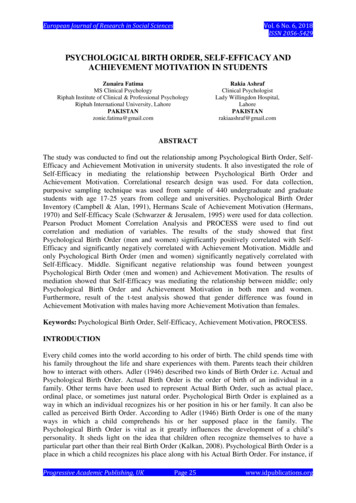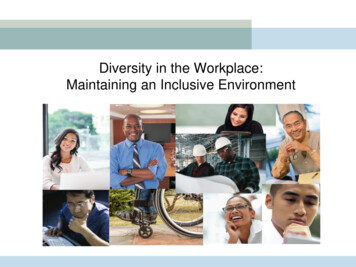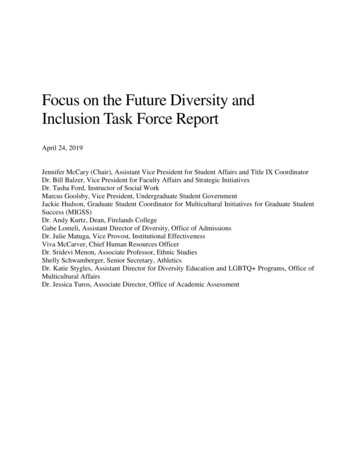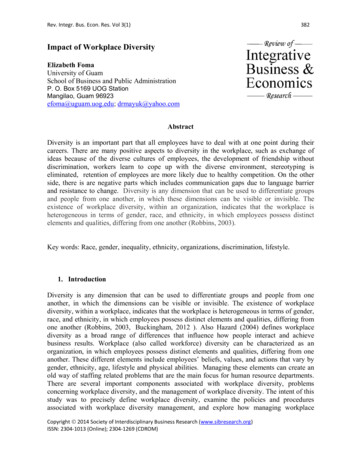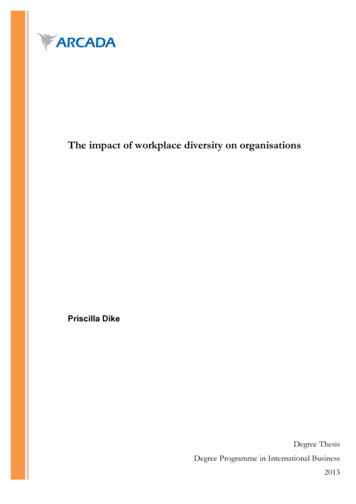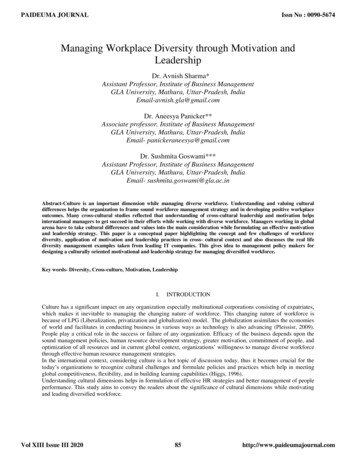
Transcription
PAIDEUMA JOURNALIssn No : 0090-5674Managing Workplace Diversity through Motivation andLeadershipDr. Avnish Sharma*Assistant Professor, Institute of Business ManagementGLA University, Mathura, Uttar-Pradesh, IndiaEmail-avnish.gla@gmail.comDr. Aneesya Panicker**Associate professor, Institute of Business ManagementGLA University, Mathura, Uttar-Pradesh, IndiaEmail- panickeraneesya@gmail.comDr. Sushmita Goswami***Assistant Professor, Institute of Business ManagementGLA University, Mathura, Uttar-Pradesh, IndiaEmail- sushmita.goswami@gla.ac.inAbstract-Culture is an important dimension while managing diverse workforce. Understanding and valuing culturaldifferences helps the organization to frame sound workforce management strategy and in developing positive workplaceoutcomes. Many cross-cultural studies reflected that understanding of cross-cultural leadership and motivation helpsinternational managers to get succeed in their efforts while working with diverse workforce. Managers working in globalarena have to take cultural differences and values into the main consideration while formulating an effective motivationand leadership strategy. This paper is a conceptual paper highlighting the concept and few challenges of workforcediversity, application of motivation and leadership practices in cross- cultural context and also discusses the real lifediversity management examples taken from leading IT companies. This gives idea to management policy makers fordesigning a culturally oriented motivational and leadership strategy for managing diversified workforce.Key words- Diversity, Cross-culture, Motivation, LeadershipI.INTRODUCTIONCulture has a significant impact on any organization especially multinational corporations consisting of expatriates,which makes it inevitable to managing the changing nature of workforce. This changing nature of workforce isbecause of LPG (Liberalization, privatization and globalization) model. The globalization assimilates the economiesof world and facilitates in conducting business in various ways as technology is also advancing (Pleissisr, 2009).People play a critical role in the success or failure of any organization. Efficacy of the business depends upon thesound management policies, human resource development strategy, greater motivation, commitment of people, andoptimization of all resources and in current global context, organizations’ willingness to manage diverse workforcethrough effective human resource management strategies.In the international context, considering culture is a hot topic of discussion today, thus it becomes crucial for thetoday’s organizations to recognize cultural challenges and formulate policies and practices which help in meetingglobal competitiveness, flexibility, and in building learning capabilities (Higgs, 1996).Understanding cultural dimensions helps in formulation of effective HR strategies and better management of peopleperformance. This study aims to convey the readers about the significance of cultural dimensions while motivatingand leading diversified workforce.Vol XIII Issue III 202085http://www.paideumajournal.com
PAIDEUMA JOURNALIssn No : 0090-56741.1 Conceptualizing workplace diversityWorkplace diversity in a global context is defined as perceived common characteristics within a given culturalcontext, and differences between the people on the basis of race, gender, ethnic group, age, personality, education,social background and more. Few research studies classified diversity into two parts including tangible or visiblediversity, like- gender, race and physical disability and intangible or invisible diversity like- religion, culture,education, tenure with an organization. (Mor-Barak, Michàlle E., 2005). Diversity management is understanding ofdifferences among employees and management of these differences as a strategy for performing organizationalworks effectively.According to Ruffino (1999), “The mixture of benefits from managing diversity includes procurement and retentionof best talent, expanding organizational flexibility, increased market share, reducing cost, better innovations,effective resolution of problems, high productivity and organizational profit.”1.2. Challenges of diversity at the workplaceTo take full advantage of workplace diversity, organization has to face many challenges such as communicationbarriers due to difference in perception, cultural background, and language differences that lead to lack of team spiritand reduced morale. Resistance to adapt change is due to changing social and cultural composition of workplace thatpose the most important challenge before the organizational leaders as how to motivate and lead the diversifiedemployees, coming from different cultural backgrounds carrying within them different expectations, differentbehavioral pattern, attitudinal differences and semantic barriers . Understanding and studying this challenge becameessential due to rising number of mergers, joint ventures and strategic alliances in recent years. This present paperhighlights some of motivational and leadership practices used in dealing with diversified workforce in globalcontext.II. MOTIVATING AND LEADING DIVERSIFIED WORKFORCEManaging people is always a challenging issue for managers working with diversified workforce. While they startmanaging people of different cultural orientations, two practices are most desirable, i.e., motivating and leadingpeople to succeed in international and global projects. That said how to motivate employees remains a frustratingand difficult process for many managers and adding cross-cultural issues to the mix make the question of employeemotivation more complex. For example motivation of employees and their responses to feedback may differsignificantly depending on cultural factors, all the talk about “globalization” and value convergence notwithstanding(Communal and Senior, 1999). In fact cultural values such as the value given to hard work and thrift may influenceemployee motivation in ways that can help to explain diverse economic development rates across nations (Granato,Inglehart and Leblang, 1996). Cultural values may influence what kind of psychological contract employees havewith their employers.2.1 Motivation theories and their application in diverse culturesIt is essential to find out the ways to motivate employees for leading the higher productivity and better attitudesespecially while dealing with diverse workforce. Managers working in global context are advised to consider thedifferences of personalities, age, gender and races of employees while attempting to motivate workforce (Puryear,2018) as shown in figure 1. It is also advisable to understand the application of various motivation theories whilemanaging and leading diverse workforce in cross-cultural context.Vol XIII Issue III 202086http://www.paideumajournal.com
PAIDEUMA JOURNALIssn No : 0090-5674Figure 1: Motivating diversified workforce,Source: http://slideplayer.com/slide/9165844/2.2 Applying Maslow’s need hierarchy theoryMaslow said that people have five needs that are triggered in a hierarchical fashion (Maslow, 1970). Employee’smotivation to follow higher order needs is very strong in highly industrialized countries, with lower order survivalneeds more significant in less developed countries. Many workers in poor countries may not have the luxury ofpursuing self actualization if their survival of safety is in question (Bhagat and Quaid, 1982; Sweeney and McFarlin,2008). Some experts feel that Maslow’s hierarchy is a philosophy that reflects American values. Its emphasis onhigher order growth needs is especially popular in the United States because American culture strongly valuesindividualism and risk taking.2.3 Applying Herzberg’s two factor approachOne study found workers in Zambia generally matched Herzberg two factor approach with growth needs and otherintrinsic factor associated with high motivation and poor relationships and bad working conditions associated withdissatisfaction (Sweeney and McFarlin, 2008). In another study British managers were more interested inresponsibility and autonomy than their French counterparts.The French on the other hand were more interested in security, fringe benefits and good working conditions thantheir British colleagues. Generally speaking these results imply that job enrichment efforts will be easier toimplement in Britain than in France. Herzberg motivators may be viewed as a way to enhance individualachievement. Managers in multinational firms should take care to learn about the local cultural environment in depthbefore attempting any motivational and job enrichment effort (Sweeney and McFarlin, 2008).2.4 Applying Equity theoryEquity theory contends that when employees perceive that they have not been treated fairly they are motivated tobring back a sense of equality (Adams, 1965). This occur when employees compare themselves with otheremployees in terms of job outcomes (e.g. pay, benefits) and job inputs (e.g. effort, skill). When the outcomes toinputs are in equilibrium employee automatically start feeling satisfaction. If it is not employees often try to bringback the balance in some way (McFarlin and Frone, 1990; Sweeney and McFarlin, 2008).Applying equity concepts in different cultures that said how different cultures define, interpret and assess fairnesscan vary considerably often in ways that are poorly understood (Morris and leung, 2000). Nevertheless, at the risk ofgeneralizing existing cultures that value individualism tend to embrace equity concepts. In such cultures individualperformance is vital (inputs) and must be rewarded based on deservingness (outcomes). In collectivist culturesrewards are distributed equally regardless of performance to protect harmony and cohesiveness among groupmembers (Hofstede, 1984; Sweeney and McFarlin, 2008). Another study illustrates how social changes may affectreward distribution preferences. In recent years many Americans have become more concerned with cooperation andless concerned with wealth. The opposite trend is happening in china as it moves away from traditional egalitarianpractices (Sweeney and McFarlin, 2008).Vol XIII Issue III 202087http://www.paideumajournal.com
PAIDEUMA JOURNALIssn No : 0090-5674Overall it can be suggested that international managers should explicitly take cultural dimensions into considerationwhen crafting and implementing motivation strategies abroad (Gomez-Mejia and Welbourne, 1991). Internationalmanagers may not recognize how their own values and biases affect the motivation strategies they use (Schneiderand Barsoux, 2003). Researchers embrace the idea that whatever motivational strategy is adopted, it should beculturally synergistic.2.5 Key leadership issues in multinationalsLeader must take cultural values into account to be effective. In fact some American, European and Japanesemultinationals have created comprehensive leadership programs to develop more effective international managers.General electric, Unilever, Nokia, and Sony corporation are just such examples (Ayman ,Kreicker and Masztal,1994).Other multinational want to substitute their corporate values for the local values that they encounter in variouscountries. These multinational believe that by emphasizing corporate values, a more homogeneous internationalwork force can be created. This would allow managers to use similar leadership strategies everywhere even if themultinational operate in dozens of countries and have thousands of foreign employees. Research suggested the bestoption for multinational may be training and career development programs aimed at developing leadership skillsthroughout the corporation (Alder and Bartholomew, 1992). But that’s just of the story. Companies need torecognize their aspirant international managers before time, using valid and trustworthy methods (Spreitzer, McCalland Mahoney, 1997) and once that happens, it will take managers time to acquire the skills for being effective crosscultural leaders.An effective global leader is one who understands and value differences among people, shows dynamism, good inglobal business acumen, having intercultural and language competence, has a good idea of values and ideals, andcan guide and motivate team members for developing cross-cultural sensitivity and making adjustment with diversegroups as shown in figure 2.Figure 2: Global LeaderSource: rship-trainingCulture can impact how employee perceives leader style and behavior. Leaders also must express their behavior inculturally specific ways to be effective. In essence, leadership style must be defined in terms of its core structure andits particular appearance in specific culture. For example, American and Japanese leaders may agree that being kindand supportive is essential for success. In the individualistic United States, a manager as a good leader might expressconcern by demonstrating respect for subordinate’s idea. In collectivistic Japan, however a manager can expresssupport by sparing good time with subordinates in group (Doktor, 1990).Vol XIII Issue III 202088http://www.paideumajournal.com
PAIDEUMA JOURNALIssn No : 0090-5674III. MANAGING DIVERSITY-CORPORATE PERSPECTIVETata Consultancy Services (TCS), one of known top IT services, consulting and business solutions organization, hasbeen presented with the 'Top Workforce' award at the third annual Diversity and Inclusion (DANDI) Awardsorganized in New York on December 1, 2014. TCS offered this award for making efforts in leading diverseworkforce in its industry, employing workforce from more than hundred ethnic groups, of which more than 100,000are female. TCS has also contributed for support of education, motivation and mentoring of women and deprivedgroups.Wipro Technologies is having an employee base of about one Lac, including people from seventy four nationalities,spread across fifty four countries, is dedicated to leveraging diversity through valuable leadership, commitment andaccountability which advance the company’s show and also improves innovation. Wipro strives to catch theattention of and retain the best talent from a globally diverse talent pool which helps for better client services andgives a strong competitive frame in the global market place. Wipro’s diversity program is fabricated on fourimportant pillars including gender, nationality and people with disabilities and deprived.In current competitive context, IBM also follows a principle of creating diversity at the workplace. It believes thatpromoting diversity not only help in creating good performances but also gives competitive advantage and build abridge between the workplace and the marketplace.IV. DISCUSSION AND PRACTICAL IMPLICATIONSToday it is globalized era that is characterized by diversified workforce and all individuals carry their own mindsetand working style because of different socio-cultural background. Thus, it becomes imperative not just to procureand develop but also to motivate and lead workforce in a globalized way.A successful leader is expected to have a better knowledge of behavioral, attitudinal and cultural differences amongpeople for handling them and keeping all as a part of one team. International managers as influential leaders need tohave good idea of varying cross-cultural characteristics for understanding differences of people behavior, habits,expectations and core beliefs. These understandings will guide them as effective leaders for managing andmotivating people, channelizing their efforts constructively and aligning them with organizational vision.This paper is useful for all managers working with international and multinational firms and gives them little bit ideaof various managerial tactics for handling diversified workforce. Developing understanding with culturally orientedmanagement practices can help managers to handle diverse workforce more smartly resulting into high workplaceproductivity. Future researchers are advised to make use of various other techniques for empirically testing theimpact of culture on employees and organizational outcomes.One should Remember “Creating and managing a diverse workforce is a process, not a destination”.R. Roosevelt Thomas, Jr.REFERENCES Adams, J.S. (1965), ‘Inequity in social exchange, In L. Berkowitz (Ed.)’, Advance in experimental social psychology, vol.2, pp. 267299. New York: Academic Press.Alder, N.J. and Bartholomew, S. (1992), ‘Managing globally competent people’, Academy of Management Executive, Vol.6, pp. 5265.Alyn, J. (2010), 12 Diversity Quotes I Love and How to Use Them. them-2/. Accessed 25 July 2017Ayman, R., Kreicker, N.A. and Masztal, J.J. (1994), ‘Defining global leadership in business environment’, Consulting PsychologyJournal, Vol.46, pp. 64-73.Banai, M. and Teng, B.S. (1996) , ‘Comparing job characteristics, leadership style, and alienation in Russian public and privateenterprises’, Journal of International management,Vol. 2,pp. 201-224.Bass, B.M. (1990): Stogdill’s handbook of leadership: A survey of theory and research. New York: Free PressBhagat, R.S. and McQuaid, S.J. (1982), ‘Role of subjective culture in organizations: A Review and directions for future research’,Journal of Applied Psychology, Vol.67, pp. 653-685.Child,J. (1981), ‘Culture, contingency, and capitalism in the cross- national study organizations, In LL Cummings & BM Staw (Eds.),Research in organizational behavior, vol.3,pp. 303-356.Communal, C. and Senior, B.(1999) , ‘National culture and management: Message conveyed by British, French, and Germanadvertisement of managerial appointments’, Leadership and Organizational Development Journal, Vol.20,pp. 26-35Vol XIII Issue III 202089http://www.paideumajournal.com
PAIDEUMA JOURNAL Issn No : 0090-5674Corporate responsibility report 2010, Employee diversity. theibmer/employee-diversity.html. accessed 26 March 2017Dorfman, P.W. and Howeell, J.P. (1998), ‘Dimension national culture and effective leadership pattern: Hofstede revisited’ .In R.N.Farmer & E.G. MCGoun (Ed.) Advances in International comparative Management, Vol. 3, pp. 127-150.Doktor, R.H. (1990), ‘Asian and American CEOs: A comparative study’, Organizational Dynamics, Vol.18, pp. .indiatimes.com/articleshow/6538780.cms?utm source contentofinterest&utm medium text&utm campaign cppst. Accessed 25 March 2017Geppert, M. (1996), ‘Path of managerial learning in the East German context’, Organization Studies, Vol.17, pp. 249-268.Gomez-Mejia, L and Welbourne, T. (1991), ‘Compensation strategy in a global context’, Human Resources Planning, Vol.14, pp. 2941.Granato, J., Inglehart, R., and Leblamg, D. (1996), ‘The effect of culture values on economic development: Theory, hypotheses, andsome empirical tests’, American Journal of political Science, Vol. 40, pp. 607-631.Gupta, A.K. and Govindarajan,V. (2002), ‘Cultivating a global mindset’, Academy of Management Executive,Vol. 16,pp. 116-126.Herzberg, F. (1996), ‘Work and the nature of man’, Cleveland, OH: World.Hofstede (1984), Culture’s consequences; Cultural constraints in management theories.House, R.J. (1971), ‘A path-goal theory of leader effectiveness’, Administrative Science Quarterly, Vol.16, pp. 321-339.Janice, R,W, Joplin and Catherine S. Daus (1997), Challenges of leading a diverse workforce ACAD MANAGE PERSPECT,Vol. 11,No.3, pp. 32-47. http://amp.aom.org/content/11/3/32.full.pdf html. Accessed 25 July 2017Kanungo, R.N. and Wright, R. W. (1983), ‘a cross culture comparative study of managerial job attitudes’, Journal of InternationalBusiness study, Vol.14, pp. 115-129.Kostera, M., Proppe, M. and Szatkowski, M. (1995), ‘Staging the new romantic heroin in the old cynical theatre: On managers, rolesand change in Poland’, Journal of organizational Behavior, Vol.16, pp. 631-646.Likert, R. (1967), The human organization. New York: McGraw-Hill.Machungwa, P.D. and Schmitt, N. (1983), ‘Work motivation in developing country’, Journal of Applied Psychology, Vol. 68, pp. 3142.Maslow, A.H. (1970), ‘Motivation and personality’, New York: Harper & Row.McFarlin, D.B. and Frone, M.R. (1990), ‘Examining a two-tier wage structure in a non-union firm’, Industrial Relation, Vol. 29, pp.145-157.Misumi,J. (1985),’The behavioral science of leadership: An interdisciplinary Japanese research programme’, Ann Arbor, Mi:University of NichiganMc Farlin D.B. and Sweeney, P.D. (2008), ‘International management: strategic opportunities and cultural challenges’,Biztantra,New-DelhiM.F.R. (2000), ‘A journey into the “Wild East”: Leadership style and organizational practices in Russia’, Organizational Dynamics,Vol.28, pp. 67-81.Morris, T., and Pavett, C.M. (1992). Management style productivity in two culture .Journal of International Business Studies, FirstQuarter, pp.169-179.Morris, M.W. and leung,K. (2000), ‘Justice for all? Progress in research on cultural variation in the psychology of distributive andprocedural justice’, Applied Psychology: An International Review, Vol. 49,pp. 100-132.Mor-Barak and Michàlle E. (2005), ‘Managing diversity: toward a globally inclusive workplace’, Thousand Oaks, Calif: SagePublications.Peterson, M.P., Brannen, M.Y. and Smith, P.B. (1994), ‘Japanese and United State leadership: Issues in current research’, InS.B.Prasad (Ed.), Advances in International comparative management, vol.9, pp. 57-82.Podsakoff, P.M.; Dorfman, P.W.; Howell, J.P. and Tudor, W.D. (1986), ‘Leader reward and punishment behavior: A preliminary testof a culture-free style of leadership effectiveness’ , In R.N. Farmer (Ed.), Advances in International comparative management,Vol. 2,pp. 95-138.Puffer, S.M. (1994), ‘Understanding the bear: A portrait of Russian business leaders’ Academy of Management Executive, Vol. 8, pp.41-54.Puffer, S.M., McCarthy, D.J. and Zhuplev, A.V. (1996). ‘Meeting Horizans’, Vol.40, pp. 52-59.Puryear, N., (2018). “How to Motivate a Diverse Workplace”. rkplace26353.html accessed on 28 May, 2018.Rodrigues, C. (1990), ‘The situational and national culture as contingencies for leadership behavior: Two conceptual Models’, In B.Prasad (Ed), Advances in international comparative management, Vol. 5, pp. 51-68. Greenwich, CT: JAI Press.Sagie,A. ; Elizur, D., and Yamauchi, H. (1996), ‘The strength and structure of achievement motivation: A cross cultural comparison’,Journal of organizational Behavior, Vol.17,pp. 431-444.Savnal, N. (2012), managing workplace diversity. t/managing-workplacediversity-112092400042 1.html. Accessed 25 March 2017.Schneider, S.C. and Barsoux, J.l.(2003): Managing across culture’, Harlow, England: Pearson Education.Shaban, A. (2016), ‘Managing and Leading a Diverse Workforce: One of the Main Challenges in Management’, Procedia - Social andBehavioral Sciences 230, pp. 76 – 84.Sinha, J.B.P. (1980), ‘The nurturant task leader: A model of effective executive’, New DelhiSinha, J.B.P. (1984), ‘A model of effective leadership in India’, International Studies of Management and Organization, Vol.14, pp.86-98.Skinner, B.F. (1969), ‘Contingencies of reinforcement’, New York: /www.tcs.com/news events/press nclusionDANDI-Award-2014.aspx. Accessed 27 March 2017Vol XIII Issue III 202090http://www.paideumajournal.com
PAIDEUMA JOURNAL Issn No : 0090-5674Spreitzer, G.M., McCall, M.W. and Mahoney, J.D. (1997), ‘Early identification if international executive potential’, Journal ofApplied Psychology, Vol.82, pp. 6-29.Sweeney, P.D. and McFarlin, D.B. (2002): Organizational behavior: Solution for management’ .Burr Ridge, IL: Irwin/McGraw-Hill.Wipro Technologies Ranked No. 2 Globally by US Diversity Diversity-Council. Accessed 30March 2017Yukl, G. (2001), ‘Leadership in organizations’, Englewood Cliffs, Nj: Prentice-Hall.Vol XIII Issue III 202091http://www.paideumajournal.com
Abstract-Culture is an important dimension while managing diverse workforce. Understanding and valuing cultural differences helps the organization to frame sound workforce management strategy and in developing positive workplace outcomes. Many cross-cultural studies reflected that understanding of cross-cultural leadership and motivation helps

